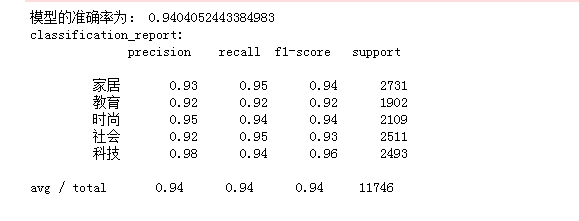一、boston房价预测
1. 读取数据集
2. 训练集与测试集划分
3. 线性回归模型:建立13个变量与房价之间的预测模型,并检测模型好坏。
4. 多项式回归模型:建立13个变量与房价之间的预测模型,并检测模型好坏。
5. 比较线性模型与非线性模型的性能,并说明原因。
二、中文文本分类
按学号未位下载相应数据集。
147:财经、彩票、房产、股票、
258:家居、教育、科技、社会、时尚、
0369:时政、体育、星座、游戏、娱乐
分别建立中文文本分类模型,实现对文本的分类。基本步骤如下:
1.各种获取文件,写文件
2.除去噪声,如:格式转换,去掉符号,整体规范化
3.遍历每个个文件夹下的每个文本文件。
4.使用jieba分词将中文文本切割。
中文分词就是将一句话拆分为各个词语,因为中文分词在不同的语境中歧义较大,所以分词极其重要。
可以用jieba.add_word('word')增加词,用jieba.load_userdict('wordDict.txt')导入词库。
维护自定义词库
5.去掉停用词。
维护停用词表
6.对处理之后的文本开始用TF-IDF算法进行单词权值的计算
7.贝叶斯预测种类
8.模型评价
9.新文本类别预测
#1.回归模型预测波士顿房价 #导入load_boston数据 from sklearn.datasets import load_boston data = load_boston() #多元线性回归模型 from sklearn.model_selection import train_test_split # 训练集与测试集划分为7:3 x_train,x_test,y_train,y_test = train_test_split(data.data,data.target,test_size=0.3) print(x_train.shape,y_train.shape) #线性回归模型:建立13个变量与房价之间的预测模型,并检测模型好 #线性回归模型公式:y=^bx+^a from sklearn.linear_model import LinearRegression mlr = LinearRegression() mlr.fit(x_train,y_train) print('系数b',mlr.coef_,"\n截距a",mlr.intercept_) #检测模型的好坏 from sklearn.metrics import regression y_predict = mlr.predict(x_test) #计算模型的预测指标 print('线性回归模型判断指数') print("预测的均方误差:",regression.mean_squared_error(y_test,y_predict)) print("预测的平均绝对误差:",regression.mean_absolute_error(y_test,y_predict)) #打印模型分数 print("模型的分数:",mlr.score(x_test,y_test)) #多项式回归模型:建立13个变量与房价之间的预测模型,并检测模型好坏。 # 多项式回归模型公式y = a0 + a1 * x + a2 * (x**2) + ... + an * (x ** n) + e from sklearn.preprocessing import PolynomialFeatures #多项式的训练集与测试集 poly2 =PolynomialFeatures(degree=2) x_poly_train = poly2.fit_transform(x_train) x_poly_test = poly2.transform(x_test) #多项回归模型 mlrp=LinearRegression() mlrp.fit(x_poly_train,y_train) #预测值 y_predict2 = mlrp.predict(x_poly_test) #检测模型预测指数的好坏 print("多项式回归模型判断指数") print("预测的均方误差:",regression.mean_squared_error(y_test,y_predict2)) print("预测平均绝对误差:",regression.mean_absolute_error(y_test,y_predict2)) #打印模型分数 print("模型的分数:",mlrp.score(x_poly_test,y_test))

import os import numpy as np import sys from datetime import datetime import gc path = 'F:\\nz258' # 导入结巴库,并将需要用到的词库加进字典 import jieba # 导入停用词: with open(r'F:\stopsCN.txt', encoding='utf-8') as f: stopwords = f.read().split('\n') def processing(tokens): # 去掉非字母汉字的字符 tokens = "".join([char for char in tokens if char.isalpha()]) # 结巴分词 tokens = [token for token in jieba.cut(tokens,cut_all=True) if len(token) >=2] # 去掉停用词 tokens = " ".join([token for token in tokens if token not in stopwords]) return tokens tokenList = [] targetList = [] # 用os.walk获取需要的变量,并拼接文件路径再打开每一个文件 for root,dirs,files in os.walk(path): for f in files: filePath = os.path.join(root,f) with open(filePath, encoding='utf-8') as f: content = f.read() # 获取新闻类别标签,并处理该新闻 target = filePath.split('\\')[-2] targetList.append(target) tokenList.append(processing(content)) #划分训练集和测试,用TF-IDF算法进行单词权值的计算 from sklearn.feature_extraction.text import TfidfVectorizer from sklearn.model_selection import train_test_split vectorizer= TfidfVectorizer() x_train,x_test,y_train,y_test=train_test_split(tokenList,targetList,test_size=0.2) X_train=vectorizer.fit_transform(x_train) X_test=vectorizer.transform(x_test) #构建贝叶斯模型 from sklearn.naive_bayes import MultinomialNB #用于离散特征分类,文本分类单词统计,以出现的次数作为特征值 mulp=MultinomialNB () mulp_NB=mulp.fit(X_train,y_train) #对模型进行预测 y_predict=mulp.predict(X_test) # # 从sklearn.metrics里导入classification_report做分类的性能报告 from sklearn.metrics import classification_report print('模型的准确率为:', mulp.score(X_test, y_test)) print('classification_report:\n',classification_report(y_test, y_predict))

# 将预测结果和实际结果进行对比 import collections import matplotlib.pyplot as plt # 统计测试集和预测集的各类新闻个数 testCount = collections.Counter(y_test) predCount = collections.Counter(y_predict) print('实际:',testCount,'\n', '预测', predCount) # 建立标签列表,实际结果列表,预测结果列表, nameList = list(testCount.keys()) testList = list(testCount.values()) predictList = list(predCount.values()) x = list(range(len(nameList))) print("新闻类别:",nameList,'\n',"实际:",testList,'\n',"预测:",predictList)





 本文探讨了使用线性和多项式回归模型预测波士顿房价的方法,并比较了两种模型的性能。此外,还介绍了如何利用TF-IDF和贝叶斯算法进行中文文本分类,包括文本预处理、特征提取及模型评估。
本文探讨了使用线性和多项式回归模型预测波士顿房价的方法,并比较了两种模型的性能。此外,还介绍了如何利用TF-IDF和贝叶斯算法进行中文文本分类,包括文本预处理、特征提取及模型评估。
















 280
280

 被折叠的 条评论
为什么被折叠?
被折叠的 条评论
为什么被折叠?








